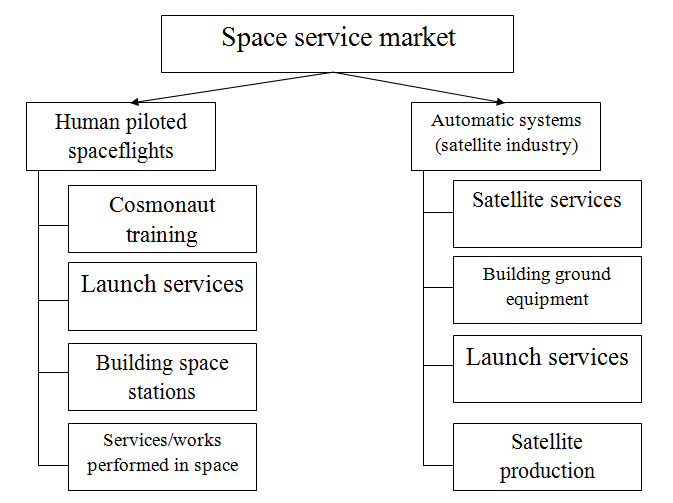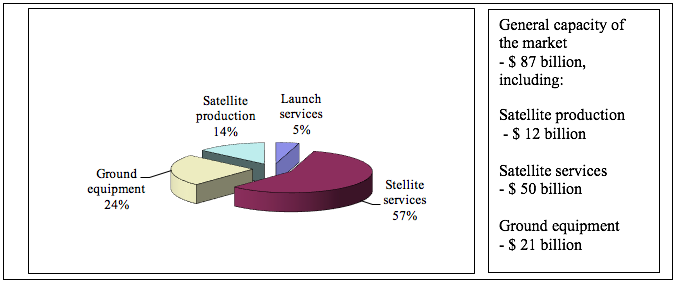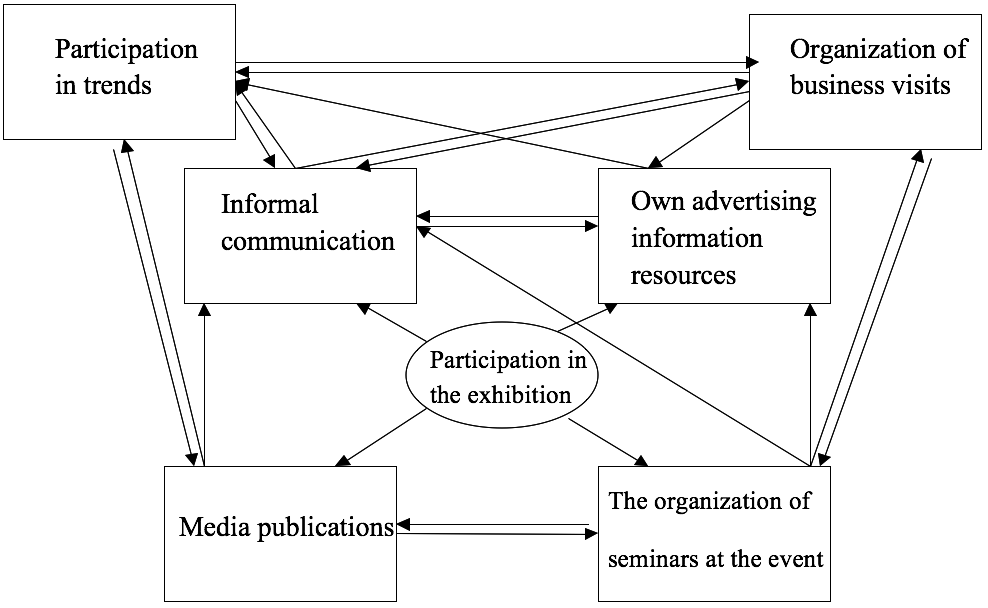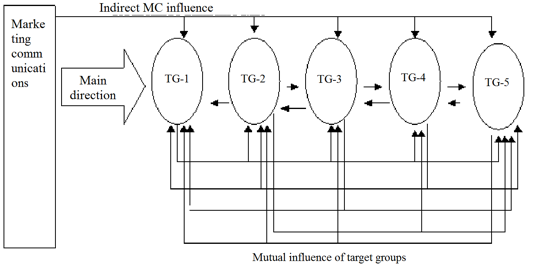Abstract
Under crisis and fierce competition even widely known corporations face a difficult problem: how to keep their positions on the market and don't lose their effectiveness. Commonly, enterprise's executives exercise a number of activities for increasing the market share, decreasing expenses in order to implement the price competition, etc. But often it is not enough for survival. Traditional marketing approaches become ineffective in new conditions of market environment. The special poignancy of managing problems is provided by inconsistency with the requirements of managing flexibility, dictated by the instability of the environment, and possibilities of project management methods, regulated by standards and guaranteeing the quality of product. In order to make a consumer loyal to specific product or service, you have to create some impression of product - positive or negative, it will appear inevitably, as soon as consumer discovers the product. Therefore, it can be said, that correctly built marketing communications are the highly effective technology of conquering and holding the consumer. In the article the nature of marketing communications and their specificities in space industry are revealed, and also the usage of different tools of marketing communications in space industry is considered.
Keywords: Marketingcommunicationsspace industryanalysisloyalty
Introduction
Marketing communications are the activity, set of tools and concrete actions of searching, analysing, generating and spreading the information important for marketing communications subjects (Aleksunin, 2009).
As the activity, it is communication policy, the special function of vendor, agent or consumer, which is effective from one's motives, interests, attitudes and goals (new market entry, introducing of new goods, increasing or keeping the market share, etc.). Forming and developing long-term partner relationships based on knowing and respecting each other and focusing on mutual benefit is current focus of this activity (Cannon, Doney, Mullen, & Petersen, 2010; Wong, Tjosvold, & Zhang, 2005).
As a set of tools, it is complex of confinement, holders and means of transportation of marketing information that allows to implement information connections, contacts in the form of advertising, public relations, direct marketing and mixed kinds (Kitchen & Moss, 1995). Current effective way to form such a complex is integrated marketing communications, communication management (Zvobgo & Melewar, 2011).
Pankruhin believes, that traditional complex of marketing communication consists of the following: advertising, public relations, personal contacts, complex forms of promoting a product to the market and sales assistance (exhibitions, fairs, salesmen educating), as well as brands and branding (as cited in Aleksunin, 2009).
Problem Statement
The effectiveness of marketing communications as an element of branding is defined by correct allocation of key target group and working with it. This is why marketing communications are analysed in terms of their influence on specific target groups.
In this article, we will try to identify the main marketing communications tools that are expedient and efficient to use in the space industry.
Research Questions
Entire market of space services can be divided in two groups (see Figure

Nowadays orders market of space industry is unstructured and "closed". Conquest and distribution of new positions are happening.
Purpose of the Study
Modern human spaceflight world market can be conditionally divided into four main segments:
Cosmonaut training.
Launch services.
Building space stations.
Services/works performed in space.
Cosmonaut training. This training takes place in Star City in Korolev. Over the life of Star City, in Cosmonaut Training Center (GCTC) over 100 cosmonaut crews were trained, a third of which are international. But the work within the cosmonaut training should be considered wider. In particular, we can include all the activity of preserving the reputation of this profession and involving the youth in space industry. So in particular, in the years 2003-2004 an "Space Odyssey" event was held in Reshetnev Siberian State University of Space and Technology involving Star City cosmonauts and RSC Energia representatives, where the best students took part. They completed the space flight training course on the Krasnoyarsk territory first, then the best of them were invited in Star City.
However, this marker niche is not highly effective in economic terms. For current space industry, there is no need in big number of cosmonauts. Meanwhile, maintaining the training infrastructure is not cheap (Mayorova, 2011).
Launch services. This market can be divided into the following parts: launch services, spaceship constructing, launch vehicle constructing, production of nodes and systems for launch/launch vehicle. This is one of the most prospective ways, where Russia has the real market. After the tragedy of February 1, 2003, while entering the atmosphere Space Shuttle Colombia was destroyed and all seven crew members died, Russian spacecrafts became the only way of transportation to ISS before the resumption of space shuttle flights. Today "Soyuz-TMA" spaceship is one of the most reliable in the world.
Constructing and maintaining space stations. Works on near-Earth orbit are being done on the International Space Station (ISS). Russia is active participant of this program. But time will tell, how economically beneficial will that participation be. Today it is more of a political decision. Meanwhile it is still under discussion, how reasonable was flooding of Russian space station "Mir". According to specialists' data, its residual value at the time of flooding was about $2.5 billion (Macatangay, Townsend, & Prokhorov, 2008).
Services/works performed in space. This course can be divided into such main parts as: scientific and technologic experiments in space conditions, advertising and space tourism services.
Space tourism currently considered one of the most prospective courses of developing peaceful outer space. But the profitability of this course for Russia is being contested by many specialists. That way, every flight of European Space Agency's cosmonauts "in the third seat" of "Soyuz-TMA" gives Russia the additional $12 million, every tourist - $20 million (that is how much South African businessman Mark Shuttleworth gave to Roscosmos for flight on April, 2001). Yet we need to take into account, that every launch of "Soyuz" costs several dozen million dollars, plus yearly rent of the Baikonur Cosmodrome and money that need to be paid to Kazakhstan and some Russian territories for spoiled ecology of the lands, because of spent rocket stages with remains of poisonous UDMH (Neronov, Chernitsova, Koroleva, & Krechetov, 2012; Lednev et al., 2018).
Automatic systems market (satellite industry). From the perspective of consumers, satellite market can be divided into commercial segment (operators of fixed and mobile satellite communications), governmental segment and military segment.
Access to "governmental" and "military" segments abroad is possible only through "political decisions".
Research Methods
World market of satellite industry comprises 4 key segments (Figure
Satellite services.
Constructing ground equipment.
Satellite production.
Launch services.

Marketing communications are an activity, set of tools and concrete actions of searching, analysing, generating and spreading the information important for marketing communications' subjects (Cannon et al., 2010).
As the activity, it is communication policy, the special function of vendor, agent or consumer, which is effective from one's motives, interests, attitudes and goals (Robins & Morley, 2002). Current focus in it is on forming and developing long-term partner relationships based on knowing and respecting each other and focusing on mutual benefit.
As a set of tools, it is complex of confinement, holders and means of transportation of marketing information that allows to implement information connections (Fedorova, Kukartsev, Boyko, Tynchenko, & Danilchenko, 2018), contacts in the form of advertising, public relations, direct marketing (including personal contacts) and mixed kinds (including exhibitions, fairs and other forms of sales assistance).
Findings
Current effective way to form such complex is integrated marketing communications, communication management.
Gaponenko and Pankruhin (2001) think, that traditional complex of marketing communication includes the following: advertising, public relations, personal contacts, complex forms of promoting a product to the market and sales assistance (exhibitions, fairs, salesmen educating), as well as brands and branding.
The effectiveness of marketing communications as an element of branding is defined by correct allocation of key target group and work with it. That is why marketing communications in this work is analysed in terms of their influence on specific target groups.
Consider the usage of means of marketing communications for various target groups.
Marketing communications with the «Customers/Decision making individuals» target group. One of the main methods of drawing attention to the product and obtaining orders in space industry is participation in tenders. However, we need to take into account that the significant role in choosing the implementer is not only proposed terms, but also the reputation of the firm - publicity and reliability of corporate brand. One of the most important tasks in promoting the product in space industry is no decrease perceived risks. Decreasing them is very important in any procurement, especially in contracts of developing and manufacturing new products (both material - spacecrafts, their parts, etc., and intellectual - developments, technical solutions, etc.). In this, it is important for «decision making individuals» know, where do they invest their funds / make an order to popular, therefore reliable corporate brand. Moreover, in space industry, as a rule, expert recommendations and thoughts affect the decision of buying a product. And thus, marketing communications play a significant role, by creating this expert assessment and spreading them among the target group.
That communications are the following:
Participation in specialized exhibitions and conferences.
Interaction with media - essentially sector and/or federal ones.
Manufacture tours.
Creating own advertising/information resources (including corporate media, websites, leaflets, flyers, souvenirs, etc.).
Informal communications targeted on forming a certain picture among target group.
Sectoral and specialized exhibits and conferences help to develop the relevant economic sectors and are the effective tool of products and services promotion. One of the significant exhibit events in Russia is International Aviation and Space Show in Zhukovsky. Siberian Aviation and Space Show applies for a role of the only winter show in Russia. Apart from that, Russian enterprises of space industry take an active part in international space shows like «FarnboroughAirshow» (United Kingdom), «ILA» (Berlin, Germany), «LeBourget» (France), «LAAD» (Latin America), «AirshowChina» (China) and many more. Enterprises participate in exhibitions by themselves (By invitation) as well as within the exhibition of Federal Space Agency or regional exposition.
Interaction with media is based on two courses. The first one is placing the advertising/image information, the second one is the creation of meaningful press events, which are interesting to media (important information about an enterprise or events connected to their activities).
According to the results of publications content-analysis (the theme is «space industry enterprises») in media, press events can be divided into several groups:
Working on the creation of an important product.
Product release (spacecraft launch, new developments, contracting).
Participation in exhibitions, shows, conferences.
Enterprise's social policy.
Historical/anniversary events.
Media interest in persons of importance, connected to the enterprise, etc.
The important role in affecting the "clients" target group in space industry is dedicated to industry mass media. Currently the most popular ones are the following: the "Russian Space" magazine, the "Space science news" magazine, the "Telesputlik" magazine and information web-recourses.
Not only industry, but also overall political or economic mass media can have a significant impact on the target group. Popular publishers ("Russian Paper", "Vedomosti", "Izvestia", etc.) and federal channels ("ORT", "RTR", "Zvezda", NTV) play a crucial role here. Getting on pages or broadcasts of these media is a measure of information's and enterprise's importance. Marketing communications like this are highly valuable, but not always can affect the «Customers/Decision making individuals» target group - the chance factor is working: information can’t be delivered to the target group.
Manufacture tours. This form of marketing communications is one of the most effective; it allows forming a coherent picture of the organization or brand. However, we need to take into account that this type of marketing communications in space industry is not primary, but appears as the logical continuation of a number of successful stages of interaction with the target group. In interaction with current target group this type of marketing communications is rather an event - a demonstration of cooperation intentions of one side and a sufficient transparency and trust of the other, the host one.
Informal communications. It is very delicate and hardly regulated, yet very effective interaction mechanism. It can be executed in context of every other way of marketing communications. Status and personal qualities of brand representative play the important role in successful communications, because branding is not only economic category, but also the psychological one (Ramsay, Barabesi, & Preece, 1996).
Apart from introduction to technical and economical rate of the product, these communications solve another problem - the problem of providing the manufacturer's image by giving certain information.
Informal communications between the organization and the customer are held on several levels. Some of those communications are strictly regulated and managed; the other part is only partly regulated, spontaneous and less manageable from organization's communication parts.
These communications can be held on different levels: company executives, top-managers, specialists, service personnel. Also, it can be the mixed kind. The most interesting for branding is access to executive and top-managers’ levels, interaction with specialists is also important. The least interesting is service personnel interaction, but this interaction is crucial to control or move the right way. The most effective and productive communications for branding are «executive-executive», «executive - top-manager» and «top-manager – top-manager». Communications on an «executive – specialist», «executive – service personnel», «top-manager – specialist» and «top-manager – service personnel» levels should be regulated and restricted. Mixed contacts are mostly possible while delegations or cooperative projects.
Complex effect of marketing communications
Already at the stage of interaction of the enterprise with one target audience, in this case, "customers/decision-makers" can observe the complex effect of marketing communications (Figure

For example, participation in exhibitions becomes an occasion for organizing a seminar in the framework of this event, all this in turn becomes a topic for publications in the media, and gives the opportunity for informal communication, determines the environment in which the company's own advertising / information tools can be delivered to the target audience - potential customers. Organizing visits to the company, that gives an opportunity to communicate informally with potential customers, becomes an occasion for an invitation to tender, and all events are accompanied by the distribution of their own advertising products. Positive publications in the media provide information for certain circles and become the starting point for inviting participation in the exhibition, seminars, conferences, etc. Therefore, in branding, it is important to support balance and use various types of marketing communications. Achieving a certain result is important to take into consideration the complex effect of marketing communications and not to ignore activities that, at first view, may seem not effective for the solution of branding problems, but in combination with other activities can give a good result.
Multiplicative nature of mass communications
It is obvious that the same marketing communications influence all target groups differently. It is impossible to affect one group without affecting another. Every marketing communication directed at one target group, automatically affect the others. Therefore, the system of firm's marketing communications has the multiplicative nature (figure

In this, the reaction can be direct or quite opposite. While keeping in mind the complex nature of marketing communications, target groups interactions and their mutual interference, we can tell about a synergetic effect of mass communications. That is why marketing communications planning is particularly important - increasing, decreasing and changing can destabilize the whole created image. Uncontrolled usage of marketing communications can move the situation to the bifurcation points (not always pleasant). In this situation, the profile and attributes of corporate brand can be changed. And in industry, where the process of sale is complicated, because of being connected with high expenses and risks, and one of the most important corporate brand traits is stability, uncontrolled changes can have negative consequences.
That is why it is important to pay particular attention to the planning and distribution of power in the structures connected to marketing communications with different target groups. Organizations should engage with that structures and keep in mind their mutual interference. These structures in most of the space industry firms include marketing, advertising and PR-structures, HR and corporate culture units. One should pay close attention to the activity of upper management - these people often are faces of the brand and a source of news for mass media. All outgoing data should be regulated.
Conclusion
It is important to mention, that the government also serves as the regulating power of marketing communications in space industry. The feature of Russian space industry is that the significant part of organizations is unitary enterprises or open joint-stock companies, but the government owns the majority of controlling interest. Because of that marketing, PR or advertising activity is regulated by the government.
In recent years, the role of the government in the life of enterprises is increasing. This has to do with the fact, that space industry is strategically important for security and economic growth of the country. That is why many marketing communications are being regulated by Roscosmos. There is even a non-official restriction of information being given to mass media.
There is a rule that the company (executive, press office, specialists) can comment on their own company's activity only. Information about space industry in general and ongoing contracts and orders can be given exclusively by Roscosmos. We should note a desire of FSA to strengthen the control of marketing communications at the agency level with the help of internal documents. It has no legal effect, but the desire itself tells us, that marketing communications of space industry enterprises (their stability and predictability) is in the area of State interests.
References
- Aleksunin, V. A. (2009). Marketing in industries and fields of activity. Moscow: Dashkov and K.
- Boyko, A. A., Kukartsev, V. V., Tynchenko, V. S., Nasyrov, I. R., & Kukartsev, V. A. (2018). State and trends of depreciation strategy of rocket and space industry enterprises formation. In Int. Conf. Actual Issues of Mechanical Engineering (AIME 2018). Advances in Engineering Research (pp. 607–611).
- Cannon, J. P., Doney, P. M., Mullen, M. R., & Petersen, K. J. (2010). Building long-term orientation in buyer–supplier relationships: The moderating role of culture. Journal of Operations Management, 28(6), 506–521.
- Fedorova, N. V., Kukartsev, V. V., Boyko, A. A., Tynchenko, V. S., & Danilchenko, Y. V. (2018). Risk insurance of cosmic projects in the Russian Federation. In Int. Conf. Economy in the Modern World (ICEMW 2018), vol. 61. Advances in Economics, Business and Management Research (pp. 199–204).
- Gaponenko, A. L., & Pankruhin, A. P. (2001). General and special management. Moscow: RAGS.
- Kitchen, P. J., & Moss, D. (1995). Marketing and public relations: the relationship revisited. J. of Marketing Communications, 1(2), 105–106.
- Lednev, S., Koroleva, T., Krechetov, P., Sharapova, A., Semenkov, I., & Karpachevskiy, A. (2018). Revegetation of areas disturbed by rocket impact in Central Kazakhstan. Ecoscience, 25(1), 25–38.
- Macatangay, A. V., Townsend, S. M., & Prokhorov, K. S. (2008). Maintaining and monitoring the habitable environment of the international space station. SAE Int. J. of Aerospace, 1(2008-01-2127), 420–428.
- Mayorova, V. (2011). Integration of educational and scientific–technological areas during the process of education of aerospace engineers. Acta Astronautica, 69(7–8), 737–743.
- Neronov, V. V., Chernitsova, O. V., Koroleva, T. V., & Krechetov, P. P. (2012). Contemporary state of vegetation in Baikonur Cosmodrome and estimate of its potential resistance to impact of space-rocket activities. Arid Ecosystems, 2(3), 186–196.
- Ramsay, J., Barabesi, A., & Preece, J. (1996). Informal communication is about sharing objects and media. Interacting with Computers, 8(3), 277–283.
- Robins, K., & Morley, D. (2002). Spaces of identity: Global media, electronic landscapes and cultural boundaries. Routledge.
- Wong, A., Tjosvold, D., & Zhang, P. (2005). Developing relationships in strategic alliances: Commitment to quality and cooperative interdependence. Industrial Marketing Management, 34(7), 722–731.
- Zvobgo, M., & Melewar, T. C. (2011). Drivers of globally integrated marketing communications: A review of literature and research propositions. J. of Promotion Management, 17(1), 1–20.
Copyright information

This work is licensed under a Creative Commons Attribution-NonCommercial-NoDerivatives 4.0 International License.
About this article
Publication Date
28 December 2019
Article Doi
eBook ISBN
978-1-80296-075-4
Publisher
Future Academy
Volume
76
Print ISBN (optional)
-
Edition Number
1st Edition
Pages
1-3763
Subjects
Sociolinguistics, linguistics, semantics, discourse analysis, science, technology, society
Cite this article as:
Danilchenko, Y., Fedorova, N., Kukartsev, V., Tynchenko*, V., & Zhereb, L. (2019). Marketing Communications In The Space Industry Of Russia. In D. Karim-Sultanovich Bataev, S. Aidievich Gapurov, A. Dogievich Osmaev, V. Khumaidovich Akaev, L. Musaevna Idigova, M. Rukmanovich Ovhadov, A. Ruslanovich Salgiriev, & M. Muslamovna Betilmerzaeva (Eds.), Social and Cultural Transformations in the Context of Modern Globalism, vol 76. European Proceedings of Social and Behavioural Sciences (pp. 3729-3737). Future Academy. https://doi.org/10.15405/epsbs.2019.12.04.500
